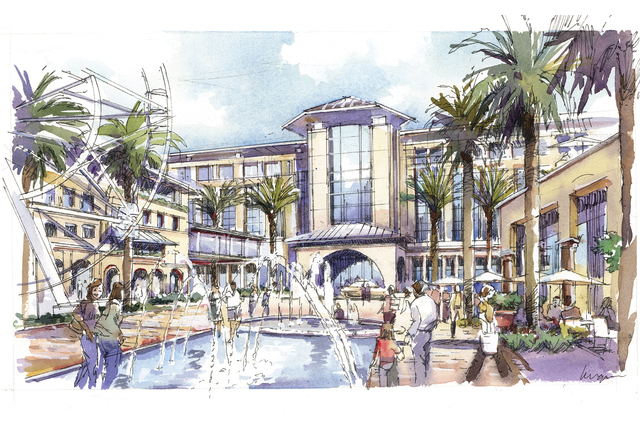Touted as the world’s largest healthcare project, the 170-unit, $1.2 billion Union Village finally broke ground on October 8 in this Las Vegas suburb.
The village, which has been in the works since 2010, is set to start construction early next year, with the first building being an acute-care hospital on 38 acres, according to the Las Vegas Journal-Review. The Valley Health System purchased this land for this facility, which will be its sixth hospital in the state.
The complex is slated to include a 315-bed hospital, and 200-bed nursing facility with long-term acute care, Alzheimer’s care, and assisted living, Healthcare Finance News reports. The hospital and medical center are scheduled to open in late 2016, according to the Journal-Review.
The goal of this village, according to its website, is to create a live-work-play environment that integrates world-class healthcare with retail, entertainment, cultural and residential centers. Nevada Gov. Brian Sandoval, who attended the groundbreaking, calls the village “a Gateway between the city of Henderson and all of Nevada.” And its medical facilities will provide all levels of healthcare whatever the age of the patient.
In April 2011, the city of Henderson approved an agreement to sell a 151 acres of city-owned property for this project for $11.6 million, according to the Las Vegas Sun’s website. At the time it quoted David Mathis, president and CEO of the Nevada Health Care Alliance, who said Union Village would provide a much-needed boost to medical infrastructure in Southern Nevada.
Craig Johnson, a senior living veteran of 20 years and the founder of Union Village, said the village would consist of four parts: the medical facilities in Union Centre; retail, offices, and residential apartments in Union Plaza; a senior community in Union Place; and a civic and cultural center in Union Park.
The buildout is expected to take a decade, reports Healthcare Finance News. The project will create 5,000 construction jobs and 12,000 healthcare and retail jobs, as well as contribute $5 billion to local and state coffers through income and property taxes over its anticipated 80-year lifespan.
Housing for 1,000 seniors will be built, along with at least 350 market-rate condominiums, Johnson told the Journal-Review. The village complex is also expected to include a movie theater, health club and hotel.
The Building Team includes: Hammes Company, Haskell, HKS, Juliet Cos., and Penta Building Group.
Related Stories
Office Buildings | Mar 21, 2024
BOMA updates floor measurement standard for office buildings
The Building Owners and Managers Association (BOMA) International has released its latest floor measurement standard for office buildings, BOMA 2024 for Office Buildings – ANSI/BOMA Z65.1-2024.
Healthcare Facilities | Mar 18, 2024
A modular construction solution to the mental healthcare crisis
Maria Ionescu, Senior Medical Planner, Stantec, shares a tested solution for the overburdened emergency department: Modular hub-and-spoke design.
Codes and Standards | Mar 18, 2024
New urban stormwater policies treat rainwater as a resource
U.S. cities are revamping how they handle stormwater to reduce flooding and capture rainfall and recharge aquifers. New policies reflect a change in mindset from treating stormwater as a nuisance to be quickly diverted away to capturing it as a resource.
Plumbing | Mar 18, 2024
EPA to revise criteria for WaterSense faucets and faucet accessories
The U.S. Environmental Protection Agency (EPA) plans to revise its criteria for faucets and faucet accessories to earn the WaterSense label. The specification launched in 2007; since then, most faucets now sold in the U.S. meet or exceed the current WaterSense maximum flow rate of 1.5 gallons per minute (gpm).
MFPRO+ New Projects | Mar 18, 2024
Luxury apartments in New York restore and renovate a century-old residential building
COOKFOX Architects has completed a luxury apartment building at 378 West End Avenue in New York City. The project restored and renovated the original residence built in 1915, while extending a new structure east on West 78th Street.
Multifamily Housing | Mar 18, 2024
YWCA building in Boston’s Back Bay converted into 210 affordable rental apartments
Renovation of YWCA at 140 Clarendon Street will serve 111 previously unhoused families and individuals.
Healthcare Facilities | Mar 17, 2024
5 criteria to optimize medical office design
Healthcare designers need to consider privacy, separate areas for practitioners, natural light, outdoor spaces, and thoughtful selection of materials for medical office buildings.
Construction Costs | Mar 15, 2024
Retail center construction costs for 2024
Data from Gordian shows the most recent costs per square foot for restaurants, social clubs, one-story department stores, retail stores and movie theaters in select cities.
Architects | Mar 15, 2024
4 ways to streamline your architectural practice
Vessel Architecture's Lindsay Straatmann highlights four habits that have helped her discover the key to mastering efficiency as an architect.
Healthcare Facilities | Mar 15, 2024
First comprehensive cancer hospital in Dubai to host specialized multidisciplinary care
Stantec was selected to lead the design team for the Hamdan Bin Rashid Cancer Hospital, Dubai’s first integrated, comprehensive cancer hospital. Named in honor of the late Sheikh Hamdan Bin Rashid Al Maktoum, the hospital is scheduled to open to patients in 2026.


















